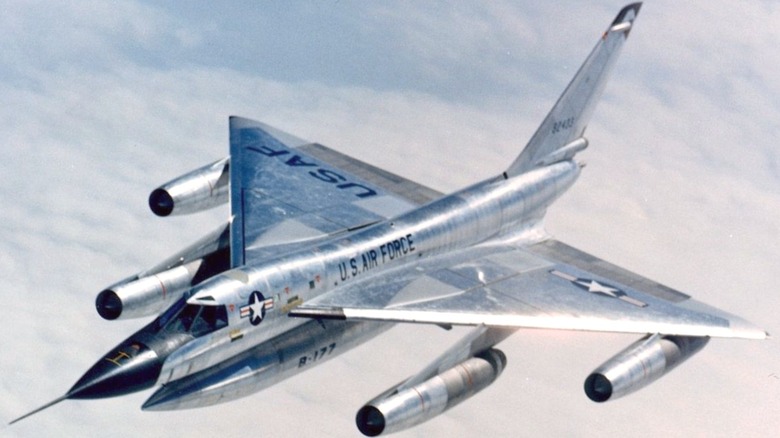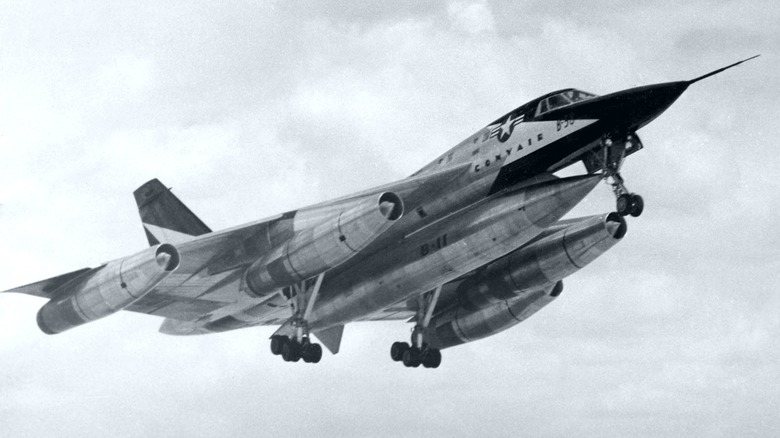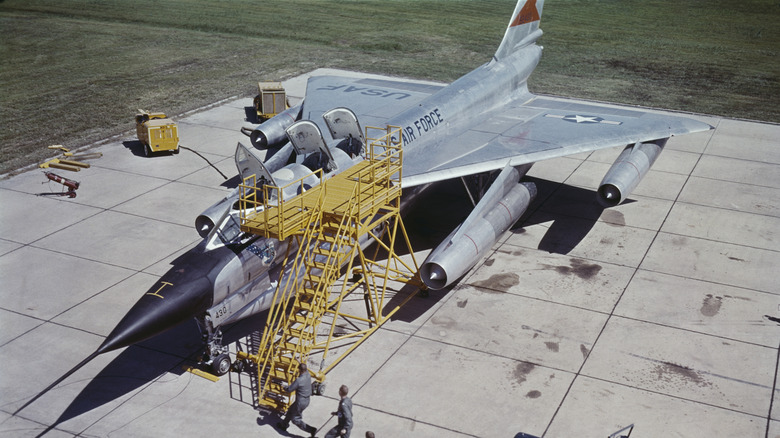Why Did The USAF Discontinue The B-58 Hustler Jet Bomber Without A Replacement?
Since its founding in 1947, the U.S. Air Force has operated a variety of aircraft. It has plenty of bombers, fighters, transport planes, and more, but not everything the Air Force flies is exceptional. For every F-16 Fighting Falcon or B-2 Spirit, there's a story about some old clunker or "flying coffin" the service once abandoned.
Typically, when an aircraft fails to meet expectations, it's replaced before being decommissioned to ensure there are no gaps in operational or strategic capabilities. This wasn't the case for the ill-fated Convair B-58 Hustler, a supersonic bomber capable of reaching Mach 2.0 (1,535 mph). In fact, the B-58 was the first operational bomber to reach that speed, so you'd think it would have a long and storied stay in the Air Force. After all, the high-speed strategic bomber pushed the limits of supersonic aviation, making it an important factor in the development of faster-than-sound technology.
The reality of the bomber's standing is much different, as it was plagued by so many problems that the Air Force opted to stop flying it before a suitable replacement was ready to take its place. When it was removed from the service's inventory in 1970, instead of something new, the Air Force opted to use the FB-111A Aardvark, itself a leading candidate for retirement.
All about the Convair B-58 Hustler
Convair's B-58 Hustler was designed with a delta wing to aid in achieving high speeds. It was powered by four General Electric J79 engines held in pods beneath the wings, clearly visible when looking at the aircraft. These provided a total of 60,000 pounds of thrust with the afterburner. While the B-58 was a bomber, it had no internal bomb bay and at first carried only a single nuclear weapon alongside fuel in a special bomb and fuel pod beneath the fuselage.
Eventually, this was altered to allow for the installation of four hardpoints, enabling the aircraft to carry up to five weapons of varying types. The B-58 made up part of America's Nuclear Triad – the policy of keeping three nuclear delivery means operational at all times. These are submarine-launched nuclear missiles, silo-based intercontinental ballistic missiles, and strategic bombers armed with bombs or other nuclear-tipped munitions.
In addition to these armaments, the B-58 sported a 20 mm cannon in the tail. It could fly as high as 64,800 feet and go as much as 4,000 miles before requiring aerial refueling. Its maximum weight was 163,000 pounds.It measured 96 feet, 10 inches long, stood 31 feet, 5 inches tall, and had a wingspan of 56 feet, 10 inches. The B-58 served for a decade before it was decommissioned despite the absence of a suitable replacement, and there were several reasons why the Air Force decided to forgo using it.
Why the Air Force grounded the B-58
There were several reasons for the B-58 Hustler's retirement, but the most crucial was the Soviet Union's development of surface-to-air missiles capable of hitting fast-moving, high-flying aircraft. Because of this, the B-58's mission was forced to change, so instead of operating as a strategic bomber immune from interception, it was relegated to low-altitude penetration missions. It wasn't designed for that kind of work, and it failed to adequately fill its new role.
That was the main reason the B-58 was grounded, but there were others dealing with the aircraft's overall design and operation. The delta wing design and high speed made for an incredibly narrow angle of attack, and on top of that, it would stall at unusual times and was challenging to fly well. Furthermore, once it began to spin, it found it almost impossible to break free. And the B-58 suffered from something called fuel stacking, which is caused by changes in the fuel's position that alter the plane's center of gravity.
This could cause the aircraft to bank or pitch in startling ways pilots were unprepared to handle. Other issues involved the B-58's high takeoff and landing speeds, which required specialized landing gear that could handle the 234 mph acceleration and required a drogue parachute to brake once it landed. So there was a complex series of design issues and maintenance problems that added up to make the B-58 one of the worst military bombers ever made.


